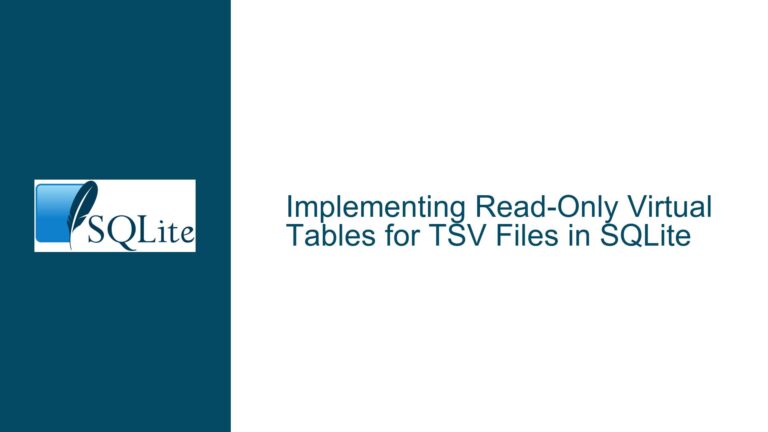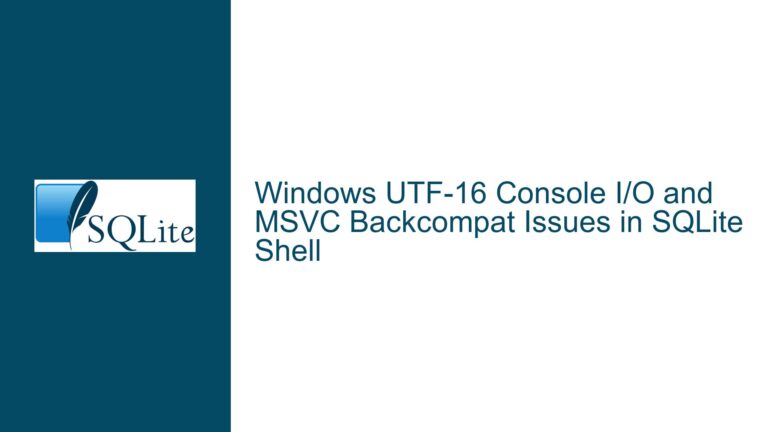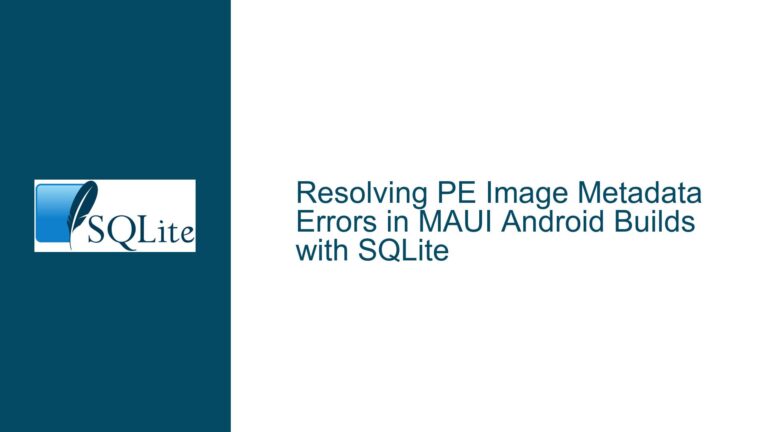Emulating SQLite WAL Mode in WASM Without Shared Memory Support
Understanding the Challenge of WAL Mode in WASM Without Shared Memory
The Write-Ahead Logging (WAL) mode in SQLite is a powerful feature that enhances concurrency by allowing readers and writers to operate simultaneously without blocking each other. However, WAL mode relies heavily on shared memory for its implementation, which poses a significant challenge in environments like WebAssembly (WASM) where shared memory is not natively supported. This limitation becomes particularly problematic when attempting to implement a custom Virtual File System (VFS) in WASM, as the absence of shared memory APIs prevents the direct use of WAL mode.
The core issue revolves around the fact that SQLite’s WAL mode requires shared memory for its operation, specifically through the xShmMap and xShmLock methods. These methods are part of the sqlite3_io_methods structure and are responsible for mapping and locking shared memory regions. In a typical environment, shared memory allows multiple processes or threads to access the same memory region, which is crucial for maintaining the consistency and performance of WAL mode. However, in WASM, the lack of shared memory support means that these methods cannot be implemented in the traditional sense, leading to the need for alternative approaches to emulate WAL mode.
One potential workaround is to use locking_mode=exclusive, which allows WAL mode to function without shared memory. However, this approach negates the primary advantage of WAL mode—improved concurrency—as it forces all database operations to be serialized. This limitation makes it unsuitable for scenarios where high concurrency is desired, such as in server-side applications or when using tools like Litestream, which depend on WAL mode for continuous replication.
Given these constraints, the challenge is to find a way to emulate WAL mode in WASM without relying on shared memory, while still maintaining the correctness and integrity of the database. This requires a deep understanding of how SQLite interacts with shared memory in WAL mode, as well as the ability to devise alternative mechanisms that can replicate the behavior of shared memory in a WASM environment.
Exploring the Role of Shared Memory in SQLite’s WAL Mode
To understand the challenges of emulating WAL mode in WASM, it is essential to delve into the role of shared memory in SQLite’s WAL implementation. Shared memory is used in WAL mode to store the WAL index, which is a critical data structure that tracks the state of the WAL file and ensures that readers and writers can operate concurrently without conflicting with each other. The WAL index is accessed through the xShmMap method, which maps the shared memory region into the process’s address space, and the xShmLock method, which provides the necessary locking mechanisms to ensure that multiple processes or threads can safely access the shared memory.
In a typical SQLite setup, the WAL index is stored in a shared memory file that is mapped into the address space of all processes accessing the database. This allows each process to read and write to the WAL index without needing to copy data between processes, which is crucial for maintaining performance. However, in WASM, the lack of shared memory support means that this approach is not feasible, as there is no way to create a shared memory file that can be mapped into the address space of multiple WASM instances.
One of the key questions that arises in this context is whether SQLite ever accesses the shared memory region without holding a lock. If SQLite does access shared memory without locking, it would imply that any emulation of shared memory in WASM would need to ensure that the WAL index is always consistent, even in the absence of locks. This is a critical consideration, as any inconsistency in the WAL index could lead to data corruption or other serious issues.
Furthermore, the use of atomic operations in SQLite’s WAL implementation adds another layer of complexity. Atomic operations are used to ensure that certain operations on the WAL index are performed in a thread-safe manner, even in the absence of locks. If these atomic operations are not properly emulated in WASM, it could lead to race conditions or other concurrency issues, further complicating the task of emulating WAL mode.
Given these challenges, it is clear that emulating WAL mode in WASM requires a careful and nuanced approach. Simply reading pages into memory when a lock is acquired and writing them back when a lock is released may not be sufficient to ensure correctness, especially if SQLite accesses shared memory without holding a lock or relies on atomic operations for consistency.
Implementing a WAL-Compatible VFS in WASM Without Shared Memory
To address the challenges of emulating WAL mode in WASM, one possible approach is to implement a custom VFS that leverages the SQLITE_IOCAP_BATCH_ATOMIC capability. This capability allows a VFS to perform batch atomic writes, which can be used to emulate the behavior of WAL mode without relying on shared memory. By diverting database writes into a log with extra metadata and managing the state to read pages back from the appropriate place, it is possible to achieve a level of concurrency similar to that of WAL mode.
The key idea behind this approach is to reimplement the core functionality of WAL mode within the VFS itself. Instead of using shared memory to store the WAL index, the VFS can maintain its own internal data structures to track the state of the WAL file. These data structures can be stored in regular memory, and the VFS can use whatever synchronization mechanisms are available in the WASM environment to ensure that they are accessed in a thread-safe manner.
One of the advantages of this approach is that it allows the VFS to use whatever data synchronization mechanisms are available in the WASM environment, without being constrained by the lack of shared memory support. For example, if the WASM environment provides some form of inter-process communication (IPC) or message passing, the VFS can use these mechanisms to propagate changes to the WAL index between different instances.
However, this approach also comes with its own set of challenges. One of the main challenges is that it requires a significant amount of work to reimplement the core functionality of WAL mode within the VFS. This includes not only managing the state of the WAL file but also reinterpreting the VFS locking calls to ensure that they are compatible with the custom implementation of WAL mode.
Another challenge is that the SQLITE_IOCAP_BATCH_ATOMIC capability journals into the page cache, which means that the size of transactions and the configuration of the cache size must be carefully managed to avoid performance issues. If the cache size is too small, SQLite may bail out of using batch-atomic writes, which would negate the benefits of this approach. Therefore, it is essential to carefully tune the cache size and transaction size to ensure that the VFS can take full advantage of the SQLITE_IOCAP_BATCH_ATOMIC capability.
Despite these challenges, this approach offers a promising way to emulate WAL mode in WASM without relying on shared memory. By reimplementing the core functionality of WAL mode within the VFS, it is possible to achieve a level of concurrency similar to that of WAL mode, while still maintaining the correctness and integrity of the database. This approach is particularly well-suited for higher-level languages, where the complexity of reimplementing WAL mode can be more easily managed than in pure C.
Conclusion
Emulating SQLite’s WAL mode in a WASM environment without shared memory support is a complex and challenging task, but it is not insurmountable. By understanding the role of shared memory in WAL mode and exploring alternative approaches such as leveraging the SQLITE_IOCAP_BATCH_ATOMIC capability, it is possible to achieve a level of concurrency similar to that of WAL mode, even in the absence of shared memory. However, this requires a deep understanding of SQLite’s internal mechanisms and a careful approach to reimplementing the core functionality of WAL mode within a custom VFS. With the right approach, it is possible to create a WAL-compatible VFS in WASM that provides the key benefits of WAL mode, including improved reader-writer concurrency and the ability to use tools like Litestream for continuous replication.






